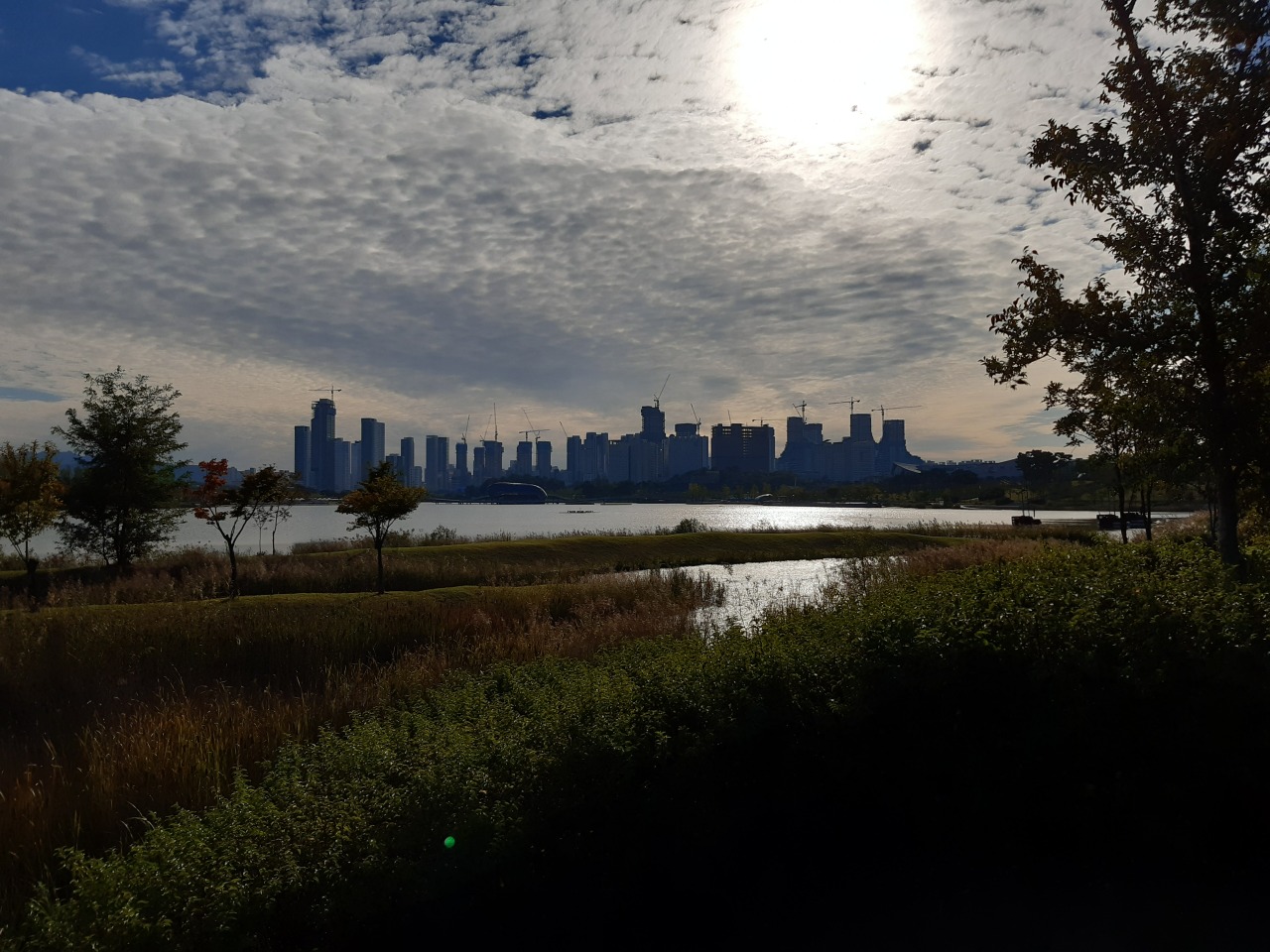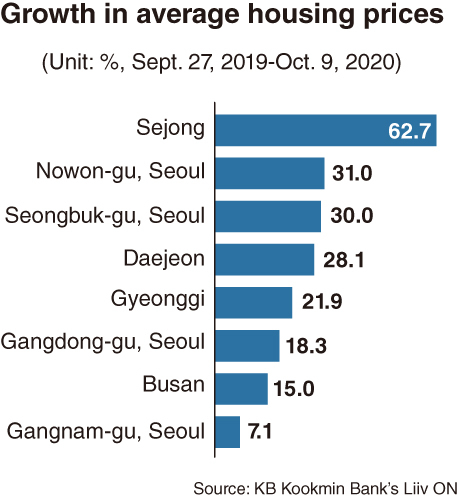
Several apartment complexes, still under construction, are seen on the horizon past Sejong’s Lake Park on Oct. 7. (The Korea Herald)
SEJONG -- The cost of housing in Seoul, including apartments, climbed 18.8 percent over the past year, while high-ranking officials continued to argue that the real estate market would stabilize on the back of “anti-speculation” measures from the government.
According to KB Kookmin Bank, the average price of housing in the capital came to 32.73 million won ($28,500) per 3.3 square meters as of Oct. 9, up 5.18 million won from 27.55 million won on Sept. 27, 2019.
This indicates that the average price for an 84-square-meter unit, the most common barometer in South Korea, climbed by 130 million won -- from 700 million won to 830 million won -- over the 12-month period.
Further, nine of the 25 administrative districts in Seoul recorded increases in the cost of housing of more than 25 percent. Nowon-gu topped the list with a 31 percent increase, followed by Seongbuk-gu with 30 percent, Geumcheon-gu with 29.7 percent and Gangbuk-gu with 29 percent.
Nos. 5 through 9 on the list were Gwanak-gu, Yangcheon-gu, Dobong-gu, Jungnang-gu and Gwangjin-gu, where housing costs increased between 25.2 percent and 27.2 percent.
Guro-gu was 10th with a 24.7 percent increase, followed by Seodaemun-gu (24.3 percent), Seongdong-gu (23.7 percent) and Dongdaemun-gu (23.1 percent).

(Graphic by Kim Sun-young/The Korea Herald)
The wealthy Gangnam-gu posted the smallest growth, with housing costs having increased 7.1 percent over the period -- from 54.91 million won to 58.83 million won per 3.3 square meters. Gangnam-gu, nonetheless, was still the most expensive of the 25 wards with an 84-square-meter home in the district going for 1.49 billion won on average as of Oct. 9. Many Gangnam-gu apartments of that size are listed at 2 billion to 3 billion won.
Seocho-gu ranked second in terms of average housing prices at 56.13 million won per 3.3 square meters. It was trailed by Songpa-gu (45.9 million won), Yongsan-gu (41.84 million won), Seongdong-gu (37.35 million won) and Yangcheon-gu (35.73 million won).
The 18.8 percent increase in the cost of housing in Seoul over the past year, coupled with the fact that some apartment complexes saw trading prices surge 50 percent to 100 percent between 2016 and 2019, could mean that the series of apartment policies implemented by the government since 2017 were not efficacious.
Nationwide, Sejong posted overwhelming growth in housing prices over the corresponding period. This was mainly attributed to remarks by some ruling party politicians suggesting the need to relocate the administrative capital from Seoul to the administrative city, where the main government complex is located.
Sejong, which was launched in July 2012, saw the average price of housing shoot up 62.7 percent -- from 11.61 million won per 3.3 square meters on Sept. 27, 2019, to 18.9 million won on Oct. 9 this year.
Housing prices in Dodam-dong, central Sejong, posted a 66.1 percent climb to 22.86 million won per 3.3 square meters, overtaking those in Seoul’s Nowon-gu (22.44 million won) and Eunpyeong-gu (22.83 million won). Further, housing prices in Sejong’s Saerom-dong recorded 24.42 million won, nearly equivalent to those in Seoul’s Seongbuk-gu (24.98 million won).
Gyeonggi Province, which surrounds Seoul, reported a 21.9 percent increase to 14.28 million won per 3.3 square meters.
Within the nation’s most populous province, Gyeonggi, Gwacheon City topped the list at 47.12 million won, followed by Seongnam’s Bundang-gu at 30.62 million won, Hanam at 25.31 million won, Gwangmyeong at 24.45 million won and Anyang’s Pyeongchon-dong at 22.27 million won.
Housing prices rose in all the nation’s eight major cities, including Seoul and Sejong. The increase stood at 28.1 percent in Daejeon, 15 percent in Busan, 14.6 percent in Incheon, 13.4 percent in Ulsan, 7.6 percent in Daegu and 3.8 percent in Gwangju.
By Kim Yon-se (kys@heraldcorp.com)







![[Graphic News] More Koreans say they plan long-distance trips this year](http://res.heraldm.com/phpwas/restmb_idxmake.php?idx=645&simg=/content/image/2024/04/17/20240417050828_0.gif&u=)